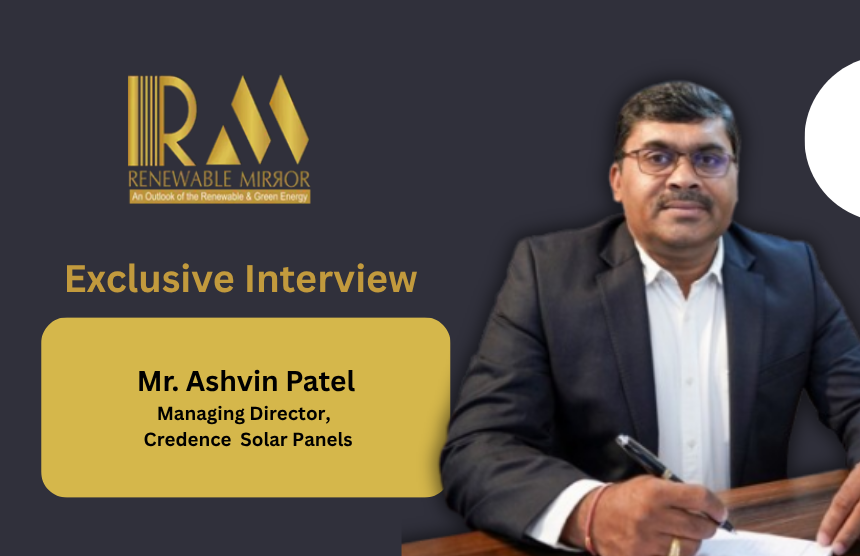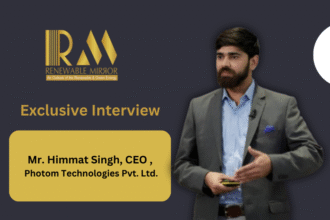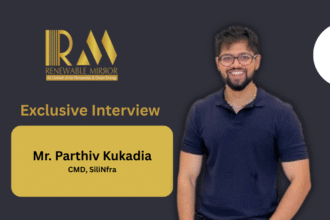Last Updated on November 6, 2025 by Author
Q1. How is Credence Solar leveraging cutting-edge technology to boost efficiency, reliability, and affordability in its solar modules across India?
At Credence Solar, our mission is to offer nothing but the best to the solar industry through technological innovation and precision engineering.
Our advanced cell and module technologies — built on TOPCon and next-generation MonoPERC platforms using 210mm wafers (18BB / 16BB) — deliver higher conversion efficiency and superior low-irradiance performance. This results in higher per-module output and a significant reduction in the Levelized Cost of Energy (LCOE).
To ensure consistency and excellence, we rely on factory automation, Artificial Intelligence (AI), and Automated Optical Inspection (AOI). Our fully automated production lines minimize human variability and enhance throughput, helping maintain competitive per-watt costs as production scales up.
AI-driven process controls continuously optimize soldering, stringing, and lamination parameters in real time, reducing the risk of microcracks and mismatch losses. Meanwhile, AOI systems instantly detect any surface or assembly defects, ensuring that only fully conforming modules progress through the production process — improving first-pass yield and lowering rework costs.
Our mechanical innovations further strengthen module reliability in real-world conditions. The unique dual back-rib structural design for large-format modules prevents glass sagging and minimizes mechanical stress on cells and interconnects, thus extending module life and reducing operation and maintenance (O&M) risks. Additionally, our glass-to-glass construction with POE encapsulation enhances moisture resistance and long-term durability compared to conventional backsheet designs.
We also maintain stringent quality control and accelerated reliability testing to ensure bankable performance. Each module undergoes multi-stage testing — including EL, IV/flash, mechanical load, PID, salt-mist, ammonia, thermal cycling, hail, and water immersion tests.
Our in-house accelerated lifetime testing (equivalent to 3× standard life-cycle simulations) verifies long-term performance, minimizes degradation uncertainty, and enhances module bankability — reducing insurance costs and improving investor confidence.
Credence’s traceability and transparency systems further enhance reliability and trust. In addition, our engineering team focuses on optimized BOM and system design. We recommend project-specific combinations of cells, encapsulants, frames, and glass to minimize lifecycle costs rather than prioritizing only upfront pricing. High-wattage modules from Credence reduce the number of panels, racks, anchors, and cables required — delivering measurable savings in Balance of System (BOS) and installation costs.
With a 2.2 GW fully automated manufacturing capacity, we leverage economies of scale and strong supplier partnerships to negotiate better material costs, ensuring affordability without compromising quality. Our proactive procurement strategy minimizes lead times, mitigates raw material price volatility, and keeps our customers informed about policy and import duty impacts.
Q2. With India aiming for domestic solar manufacturing by 2026, how is Credence Solar scaling its production and supply chain to meet policy requirements and growing demand?
Our strategy revolves around scaling both our manufacturing capacity and supply chain resilience in a structured and forward-looking way. We currently operate a fully automated 2.2 GW. This Capacity is built around advanced automation, AI-driven process control, and higher-wattage technologies like G12, G12R and M10R TOPCon modules up to 730W, ensuring we stay ahead in both efficiency and reliability.
Our proactive procurement strategy and long-term contracts with key suppliers mitigate volatility in raw material pricing and availability — a critical factor in maintaining steady output and cost competitiveness.
We’re also investing in AI-based inventory and production planning tools, which help synchronize upstream materials with downstream demand, reducing lead times and ensuring faster fulfillment. Our approach combines scalable production, smart automation, and domestic value-chain development, positioning Credence Solar to not only meet India’s renewable goals but to contribute meaningfully to the vision of a globally competitive solar manufacturing ecosystem.
Q3. What steps is Credence Solar taking to embed sustainability and circular economy practices into manufacturing, recycling, and resource efficiency?
Sustainability isn’t just an outcome of what we produce — it’s embedded into how we produce. We see it as our responsibility to ensure that every stage of our value chain — from material sourcing to manufacturing and end-of-life management — aligns with the principles of sustainability and circular economy.
Firstly, our manufacturing process is designed for maximum resource efficiency. We operate a fully automated and AI-integrated production line, which minimizes material waste, reduces energy consumption, and ensures consistent quality. We’ve implemented closed-loop water systems, low-emission soldering, and smart energy management across our plant to reduce carbon footprint and operational energy intensity.
Secondly, we are increasingly focusing on sustainable material selection — using POE encapsulants, glass-to-glass designs, and recyclable module components that extend product life while simplifying future recycling. Our dual back-rib design also enhances mechanical durability, reducing premature failure and thereby lowering lifecycle waste.
Q4. Credence Solar has recently expanded its production capacity and introduced new high-efficiency solar modules. How do these developments strengthen your market position and support India’s renewable energy targets?
Our recent capacity expansion and introduction of new high-efficiency modules are both strategic and purpose-driven steps toward aligning with India’s renewable energy vision. With our production capacity now scaled to 2.2 GW, supported by a fully automated, AI-enabled manufacturing line, Credence Solar is better equipped to meet the rapidly increasing domestic demand while ensuring consistent quality and timely delivery.
The new generation of high-efficiency G12, G12R,& M10R TOPCon and MonoPERC modules, ranging up to 730W, are designed to deliver superior performance and reliability. These modules not only raise energy yield per square meter but also reduce the Levelized Cost of Energy (LCOE) for developers — directly supporting India’s mission to make solar power more affordable and accessible.
In addition, our dual back-rib module design and glass-to-glass architecture improve long-term durability and operational stability, ensuring better asset longevity for projects across diverse Indian climates.
From a market perspective, these advancements strengthen our leadership position as one of the few Indian manufacturers offering large-format, high-wattage, ALMM- and BIS-approved modules — fully aligned with Atmanirbhar Bharat and Make in India goals.
Q5. With Credence Solar already established as a leading PV module manufacturer, are there any plans to move upstream into solar cell manufacturing? If so, what would be the strategic focus — technology selection, capacity, or integration with existing module lines?
Yes, the decision to move into solar cell manufacturing was made earlier, and we are already on track with our plan. The cell line is expected to become operational around the time the ALMM mandate on cells is enforced.
In line with our philosophy at Credence Solar, our goal is to establish a technologically advanced and future-ready facility that bridges the efficiency gap in the domestic solar value chain. The upcoming 4 GW cell manufacturing line will be equipped to produce the latest high-efficiency technologies, ensuring compatibility with our advanced module platforms.
This new facility will be based in Rajkot, Gujarat—alongside our existing module manufacturing operations—to ensure seamless integration, better supply chain control, and faster scalability as the market evolves.
Q6. At REI Expo 2025, what product innovations, launches, or collaborations can attendees look forward to, and how do they align with India’s clean energy goals?
At REI, we will be showcasing our hot-selling products, including 730W in G12, 650W and 600W in M10R, along with G12 MonoPERC. Our focus will be on demonstrating to the industry why Credence is your ideal module partner.
We will provide a platform highlighting the performance of our modules, giving attendees clear insights into the practical differences between our offerings and other market products, instilling confidence in the value and reliability of Credence modules.










